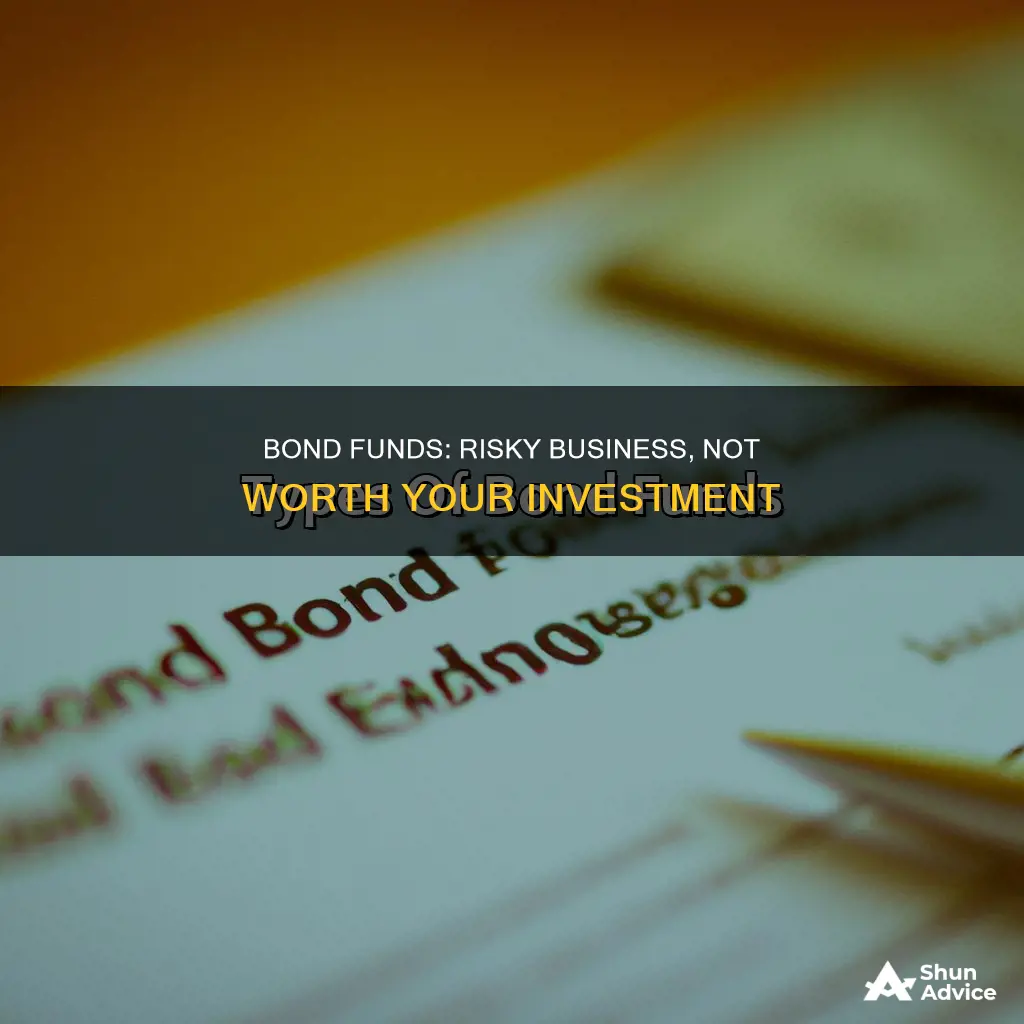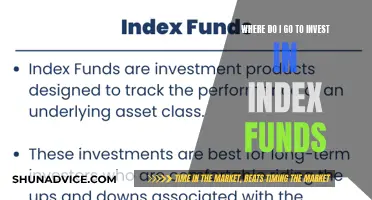
Investing in bond funds is a topic that raises many questions. Bonds are a way for organisations to raise money by borrowing from investors. They are considered a relatively safe investment option, providing a steady stream of income and lowering risk when compared to stocks. However, investing in bond funds also has its drawbacks. This paragraph aims to introduce the topic of why one may choose not to invest in bond funds, exploring the potential disadvantages and risks associated with this investment option. By understanding the cons of investing in bond funds, individuals can make more informed decisions about their financial strategies and explore alternative options for their investment portfolios.
| Characteristics | Values |
|---|---|
| Control and transparency | Lower |
| Research and oversight | Lower |
| Credit risk | Varied |
| Transaction costs | Higher |
| Frequency of income | Monthly |
| Minimum investment amount | Lower |
| Liquidity | Higher |
| Impact of rising or falling rates | Potentially greater |
| Management fee | Higher |
| Net asset value | Fluctuates with the market |
| Cost basis and tax consequences | Different |
What You'll Learn

Bond funds have higher management fees and commissions
Investing in bond funds can be more expensive than investing in individual bonds because of the higher management fees and commissions. Management fees for actively traded bond funds can be high, which may result in lower returns. In contrast, when you own individual bonds, there is usually only a commission charged when the bond is purchased, and unless it is sold before its maturity date, there are no other charges.
Bond funds are managed by professionals, and this active management comes at a cost. The management fees cover the costs of research and management and are levied on an ongoing basis. Depending on the fund and where you buy it, there could be additional transaction or sales fees.
The ongoing management fees are reflected in the net asset value (NAV) of a bond fund, which will fluctuate with the market. As interest rates rise and fall, so too will the NAV of a bond fund. This market fluctuation means that there is no certainty about what the NAV will be in the future, and this makes bond funds less attractive than individual bonds when planning for future liabilities.
In addition to management fees, you may be charged a redemption fee if you sell your shares within a certain time frame. For example, you may be charged a redemption fee if you sell your shares within 60 to 90 days of buying them.
Pension Funds' Investment Choices: What, Why, and How?
You may want to see also

Income on bond funds can fluctuate
While bonds are a relatively safe investment, they are not without risk. The most common and easily understood risk associated with bonds is credit risk, which refers to the possibility that the issuer will default and be unable to pay back investors' principal or make interest payments.
Treasury bonds and other types of fixed-income investments are also sensitive to interest rate risk. This refers to the possibility that a rise in interest rates will cause the value of the bonds to decline. Bond prices and interest rates move in opposite directions, so when interest rates fall, the value of fixed-income investments rises, and when interest rates go up, bond prices fall.
If interest rates rise and you sell your bond before its maturity date, you could end up receiving less than what you paid for it. Similarly, if you own shares in a bond fund or bond exchange-traded fund (ETF), its net asset value will decline if interest rates rise. The degree to which values will fluctuate depends on several factors, including the maturity date and coupon rate on the bond or the bonds held by the fund or ETF.
Using a bond's duration can help gauge interest rate risk. Duration is expressed in terms of years and considers a security's interest payments in addition to the time until maturity. Bonds with long maturities and low coupons have the longest durations and are more sensitive to changes in market interest rates, making them more volatile. Conversely, bonds with shorter maturities or higher coupons have shorter durations and are less sensitive to changing rates, making them less volatile.
Capital Protection Funds: Secure Your Investments
You may want to see also

You may be charged a redemption fee
Redemption fees are a common feature of many financial products, including mutual funds, ETFs, and bonds. They are fees charged by the issuer or fund manager when an investor redeems or sells their shares or bonds before a certain period.
Redemption fees are typically charged as a percentage of the amount being redeemed, such as 1% to 2% of the amount of the transaction. However, they can also be charged as a flat fee, where the investor is charged a set amount for each redemption, regardless of the amount being redeemed.
Redemption fees are designed to discourage investors from withdrawing their money too soon and to compensate the fund for the costs associated with selling securities and rebalancing the portfolio. They can also help to reduce the impact of market volatility and speculation, providing more stable returns for long-term investors.
For example, if an investor is redeeming $10,000 and the redemption fee is 2%, they will be charged $200 in fees. This fee is then added back into the mutual fund, where it can be invested in the fund's portfolio.
It is important to note that redemption fees are usually only applied when shares are sold within a specified time frame, typically 30 to 90 days, although this can stretch to 180 days, one year, or more. These fees are meant to discourage short-term trading and protect long-term investors.
To avoid redemption fees, investors can consider the following:
- Know the redemption fee schedule and time your redemption to minimize or avoid the fee.
- Choose a no-load fund, which does not charge a sales commission or redemption fee, although these funds may have higher expense ratios.
- Invest in a fund with a lower redemption fee, either a flat fee or a percentage of the redemption amount, depending on the amount being redeemed.
- Consider the tax implications, as redemption fees may have tax consequences, especially in a taxable account.
- Consult a financial advisor to navigate the complex world of mutual funds and ETFs, although advisor fees should also be considered.
Transamerica 401k: Where to Invest Your Funds Wisely
You may want to see also

Bond funds that are leveraged have greater risk
Leveraged bond funds are those that use debt to finance their underlying assets. They attempt to increase their returns by using borrowed money or derivatives to multiply investment returns. For example, a three-times leveraged bond fund with $100 million in assets from its investors may borrow another $200 million against shareholder capital to purchase more bonds and triple their gains. However, this also has the potential to triple their losses.
The risks and rewards to investors depend on how well the underlying bonds in the fund perform. If the underlying portfolio return is positive, a leveraged fund will typically have higher returns than an unleveraged fund with the same portfolio. Conversely, if the underlying portfolio return is negative, a leveraged fund will have greater losses than an unleveraged fund.
Leveraged bond funds are subject to greater volatility and are not considered suitable for long-term investments. They are meant for day-to-day trading, and their results over longer periods are unpredictable and can significantly compound losses. The use of derivatives in leveraged funds can also create hidden risks for ordinary investors, as they may not realise they are investing in a mixed-bond and bond derivative fund.
Overall, while leveraged bond funds offer the potential for higher returns, they also come with significantly higher risk and volatility and are therefore more suitable for experienced investors who can tolerate higher risk.
Emergency Fund Strategies: Philippines Investment Options
You may want to see also

Lack of control over the fund's contents
When investing in bond funds, you have less control over the contents of your portfolio. While you can choose the fund you invest in, you don't have control over the exact bonds the fund holds. Funds have stated objectives and guardrails around what they may invest in, but within those limits, it's up to the fund manager to decide which securities to invest in. This means that, unlike with individual bonds, you may end up investing in bonds that don't align with your financial goals or risk tolerance.
Mutual funds must publish their complete holdings periodically, but this information is often only available a few times a year and with a lag. ETFs generally offer greater transparency than mutual funds, disclosing their complete holdings daily. However, the lack of control over the fund's holdings can make it difficult to plan for future liabilities. The net asset value (NAV) of a bond fund will fluctuate with interest rates and market conditions, and there's no certainty as to what the NAV will be at any point in the future.
Additionally, with bond funds, you don't have control over the buying and selling of individual bonds, which can lead to capital gain distributions at the end of the year. These capital gain distributions can be challenging to anticipate and plan for from a tax standpoint. In contrast, individual bonds offer a more predictable value at maturity and a more straightforward cost basis for tax purposes.
If you invest in a bond fund, you also don't have control over the fund's management fees, which can be high for actively traded funds and lead to lower returns.
Overall, while bond funds offer greater diversification and access to institutional pricing, the lack of control over the fund's contents, management fees, and buying and selling of individual bonds can be a significant downside for investors who want more predictability and control over their investments.
Mutual Fund Strategies: Long-Term Investments for Financial Freedom
You may want to see also
Frequently asked questions
Individual bonds offer more control and transparency over your portfolio. You know exactly what you own and can plan your income stream more effectively. Individual bonds also have a predictable value at maturity and their own cost basis, which is useful for tax planning.
You need a large amount of bonds to achieve adequate diversification, which can be costly. Pricing is generally less attractive than what institutional investors receive. Individual bonds also require significant time and effort to research and manage.
Bond funds offer greater diversification per dollar invested, access to institutional pricing, and professional management.
Bond funds usually have management fees, and the net asset value will fluctuate with the market. They also have a different cost basis and tax consequences compared to individual bonds.
The decision depends on your personal investment goals, time horizon, and risk tolerance. Consider the amount you have to invest, your financial goals, and your behavioural preferences. Individual bonds may be more suitable if you want predictable value and certainty, while bond funds may be better if you seek professional management and greater diversification.







